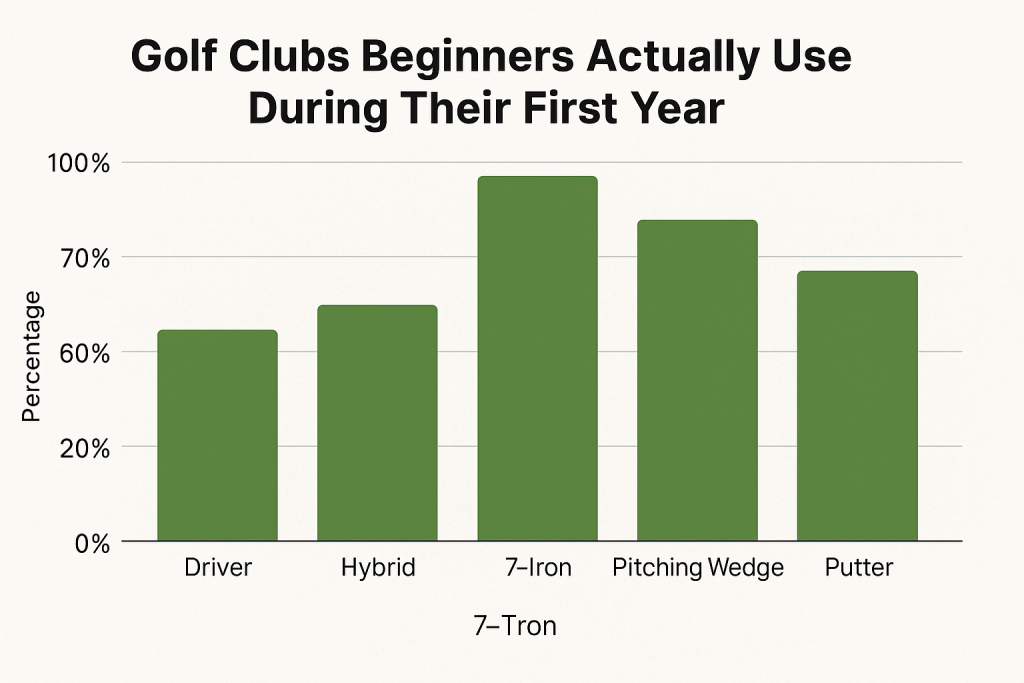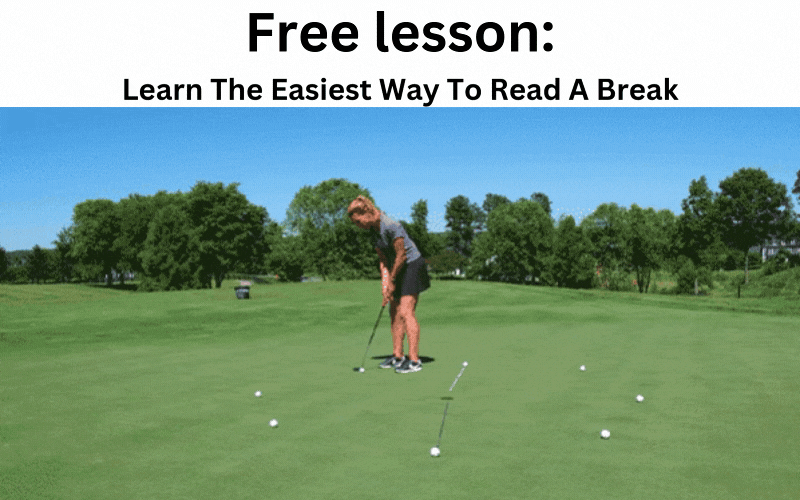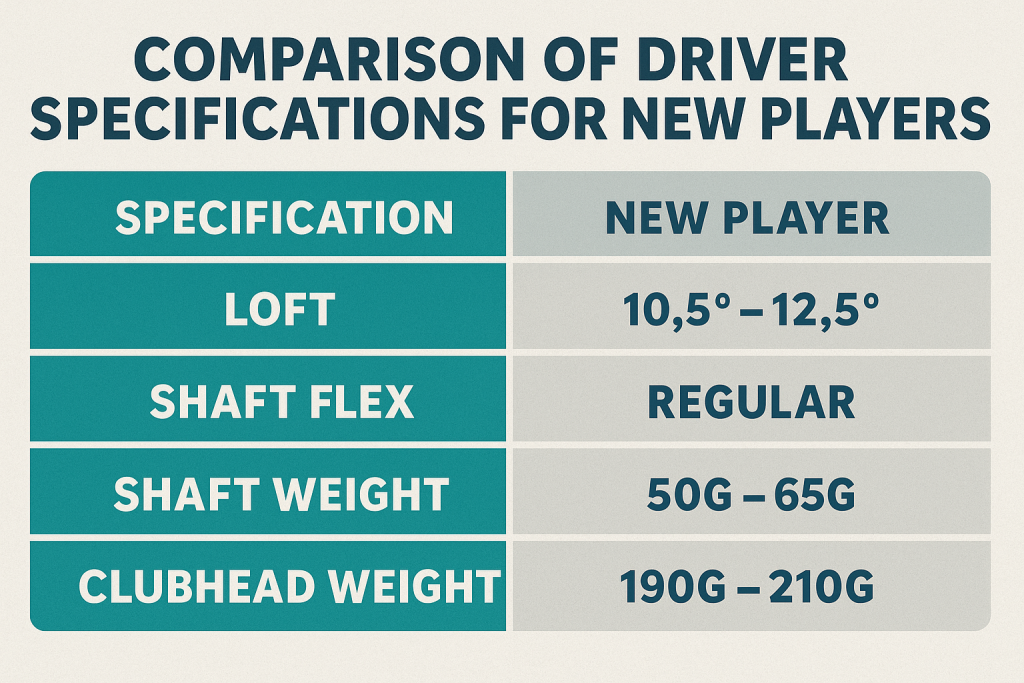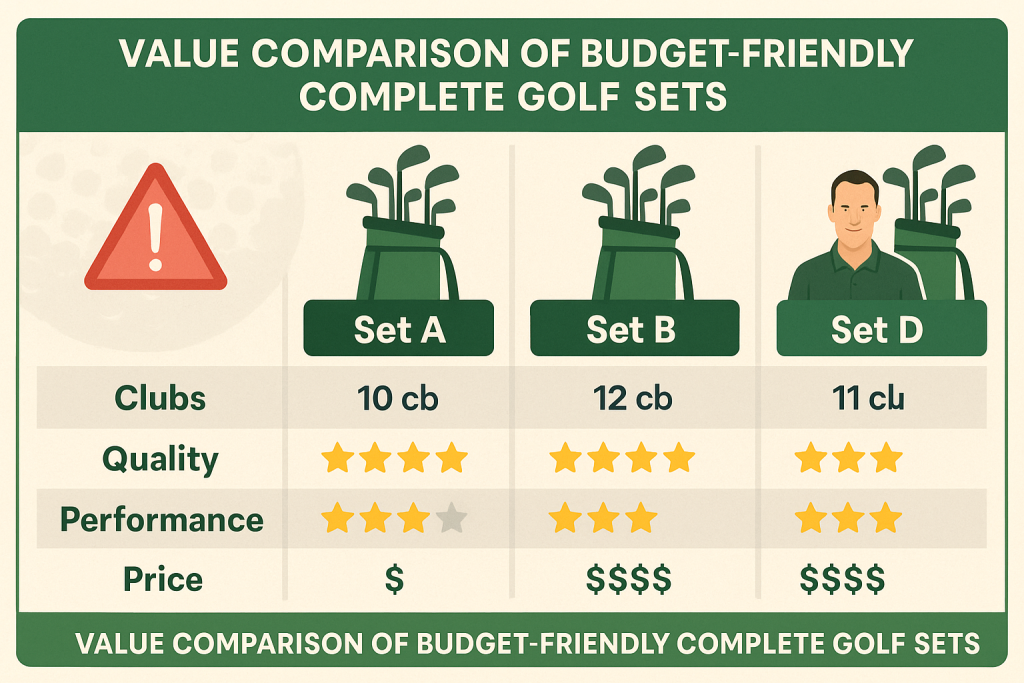Last Updated: July 2025
“Do I really need all 14 clubs?”
Standing in a golf shop surrounded by drivers, irons, wedges, and putters, every new golfer feels overwhelmed.
The salesperson is talking about loft angles and shaft flex while you're just wondering if you can play golf with fewer than 20 clubs in your bag.
Here's the truth that no one in the golf industry wants to tell you: You can play great golf with 7-8 clubs.
Most beginners would actually improve faster with fewer clubs, not more. The 14-club limit is a maximum, not a requirement.
After fitting thousands of beginning golfers and watching their progression, I've identified exactly which clubs you actually need, which ones you can skip, and which ones will help you improve the fastest.
The reality: The golf industry wants to sell you a complete 14-club set, but smart beginners build their bag strategically, focusing on clubs they'll actually use while learning the game.
In this complete guide, you'll discover:
- The 7 essential clubs every beginner needs
- Which expensive clubs you can skip (and save $500+)
- How to build your bag progressively as you improve
- Budget-friendly options that perform like premium clubs
- When to upgrade and what to look for
- Complete beginner set recommendations at every price point
Let's cut through the marketing hype and build you a golf bag that makes sense for learning the game.
The Beginner Golf Bag Reality Check
The 14-Club Myth
Golf allows up to 14 clubs, but beginners typically use only 7-8 regularly:
Clubs You'll Use 80% of the Time:
- Driver (tee shots)
- 7-iron (most versatile iron)
- Pitching wedge (around the green)
- Putter (every hole)
- Sand wedge (bunkers and short shots)
- 5-hybrid (replaces difficult long irons)
- 9-iron (shorter approach shots)
Clubs That Collect Dust:
- 3-iron through 5-iron (too difficult for beginners)
- Multiple wedges (confusing for new players)
- 3-wood (harder to hit than driver for many beginners)
- Multiple putters (stick with one)
According to Golf Equipment Manufacturers Association data, beginners use an average of 6.2 different clubs per round, despite carrying 12-14 clubs.
The Progressive Building Approach
Start small and add clubs as you improve:
Phase 1: Starter Set (6 clubs)
- Driver
- 7-iron
- 9-iron
- Pitching wedge
- Sand wedge
- Putter
Phase 2: Expanding (8 clubs)
- Add: 5-hybrid
- Add: 6-iron
Phase 3: Complete Beginner Bag (10-12 clubs)
- Add: 8-iron
- Add: Gap wedge
- Add: 3-wood or 5-wood
Phase 4: Advanced Beginner (14 clubs)
- Add: Additional irons or specialty clubs based on your game
The 7 Essential Clubs Every Beginner Needs
1. Driver – Your Distance Club
Why you need it: Tee shots on par 4s and par 5s What to look for: 10.5-12° loft, lightweight shaft, forgiving head
Top Beginner Driver Recommendations:
Budget Option: Callaway Mavrik Max ($199)
- Large, forgiving clubhead
- Built-in draw bias to reduce slices
- Lightweight design for easier swing
- Best for: Beginners focused on forgiveness over distance
- View on Amazon
Mid-Range: TaylorMade SIM2 Max ($329)
- Advanced forgiveness technology
- Adjustable loft settings
- Premium feel and sound
- Best for: Beginners who want room to grow
- View on Amazon
Premium: Ping G425 Max ($488)
- Maximum forgiveness and distance
- Excellent build quality
- Proven performance for all skill levels
- Best for: Beginners investing in long-term equipment
- View on Amazon
2. 7-Iron – Your Most Important Club
Why you need it: Most versatile iron, used for learning swing fundamentals What to look for: Game improvement design, perimeter weighting, wide sole
Key Features for Beginners:
- Large sweet spot for mishits
- Low center of gravity for easier launch
- Strong loft for confidence-building distance
- Progressive offset to square the clubface
Recommended Iron Sets:
Budget: Wilson D7 Complete Set ($379)
- Complete 6-iron through pitching wedge
- Lightweight design
- Game improvement technology
- Best for: Budget-conscious beginners
- View on Amazon
Mid-Range: Callaway Big Bertha B21 ($699)
- Advanced A.I. face design
- Maximum forgiveness
- Premium materials and feel
- Best for: Serious beginners wanting quality
- View on Amazon
Premium: Ping G425 Irons ($1424)
- Tour-proven technology
- Excellent feel and feedback
- Long-term durability
- Best for: Beginners planning to keep clubs long-term
- View on Amazon
3. Pitching Wedge – Your Scoring Club
Why you need it: Approach shots from 100-130 yards, chipping around greens What to look for: Usually comes with iron set, 45-48° loft
How to Use Your Pitching Wedge:
- Full swings from 100+ yards
- Three-quarter swings from 80-100 yards
- Bump and run chips around the green
- Basic bunker shots (until you get a sand wedge)
4. Sand Wedge – Your Short Game Savior
Why you need it: Bunker shots, short chips, flop shots What to look for: 54-56° loft, bounce appropriate for your courses
Understanding Wedge Bounce:
- Low bounce (6-8°): Firm conditions, tight lies
- Medium bounce (10-12°): Most versatile, good for beginners
- High bounce (14°+): Soft conditions, deep bunkers
Top Sand Wedge Picks:
Budget: Cleveland CBX 2 ($114)
- Beginner-friendly design
- Cavity back for forgiveness
- Multiple bounce options
- Best for: New players learning short game
- View on Amazon
Mid-Range: Titleist Vokey SM9 ($220)
- Tour-proven performance
- Multiple grind options
- Premium feel and spin
- Best for: Beginners wanting tour-level performance
- View on Amazon
5. Putter – Your Most Used Club
Why you need it: Used on every hole, accounts for 35-40% of your strokes What to look for: Alignment aids, forgiving face, comfortable feel
Chart Placeholder 3: Putter Types for Beginners Comparison of putter styles and their benefits
Putter Categories:
Blade Putters:
- Traditional look and feel
- Better feedback on mishits
- Preferred by better players
- Best for: Golfers with consistent stroke
Mallet Putters:
- More forgiving on mishits
- Better alignment features
- Higher MOI (stability)
- Best for: Beginners and inconsistent putters
Recommended Putters:
Budget: Odyssey White Hot OG ($166)
- Proven White Hot insert
- Multiple alignment options
- Tour-tested performance
- Best for: Budget-conscious beginners
- View on Amazon
Mid-Range: TaylorMade Spider GT ($204)
- High MOI design
- Excellent alignment features
- Stable on mishits
- Best for: Beginners wanting maximum forgiveness
- View on Amazon
Premium: Scotty Cameron Studio Select ($469)
- Premium feel and craftsmanship
- Tour-proven performance
- Long-term investment piece
- Best for: Serious golfers wanting the best
- View on Amazon
6. 5-Hybrid – Your Long Iron Replacement
Why you need it: Easier to hit than long irons, versatile from multiple lies What to look for: 24-27° loft, hybrid design with wide sole
Hybrid vs. Long Iron Benefits:
- Easier to launch: Lower center of gravity
- More forgiving: Larger sweet spot
- Versatile: Works from fairway, rough, even light rough
- Confidence-inspiring: Looks easier to hit
Top Hybrid Recommendations:
Budget: Tour Edge Hot Launch E521 ($79)
- Maximum forgiveness design
- Easy launch characteristics
- Great value for money
- Best for: Budget beginners
Mid-Range: Callaway Mavrik Max ($149)
- A.I. designed face
- Draw bias for slice correction
- Premium materials
- Best for: Beginners wanting advanced technology
7. 9-Iron – Your Precision Club
Why you need it: Shorter approach shots, precise distance control What to look for: Usually part of iron set, 40-42° loft
When to Use Your 9-Iron:
- Approach shots from 120-140 yards
- Punch shots under trees
- Controlled shots in windy conditions
- Learning proper iron technique
Clubs You Can Skip as a Beginner
Long Irons (3, 4, 5-iron)
Why skip them:
- Extremely difficult to hit consistently
- Low loft makes ball flight challenging
- Hybrids do the same job better
- Will frustrate you more than help
Replace with: Hybrids or fairway woods
Multiple Wedges
Why skip them:
- Too many options create confusion
- Pitching wedge and sand wedge cover 90% of situations
- Focus on mastering two wedges first
- Add specialty wedges later as you improve
Start with: Pitching wedge (included in iron set) + Sand wedge
3-Wood
Why skip it initially:
- Harder to hit than driver for many beginners
- Similar distance to hybrid but less forgiving
- Adds complexity without much benefit
- Can be added later if needed
Replace with: 5-hybrid or 7-wood (more forgiving)
Money-Saving Tip
Instead of buying a complete 14-club set:
- Buy a 6-7 club starter set
- Add individual clubs as you improve
- Save $300-500+ vs. complete sets
- End up with better-fitted clubs for your game
Building Your Bag by Budget
Budget Beginner Set ($400-600)
Complete Set Option: Wilson Profile SGI Complete Set ($388)
- Driver, fairway wood, hybrid, 6-PW irons, sand wedge, putter, bag
- Game improvement technology throughout
- Everything needed to start playing
- Best for: Beginners wanting everything at once
- View on Amazon
Build-Your-Own Budget Bag:
- Driver: Callaway Mavrik Max ($199)
- Iron Set: Wilson D7 6-PW ($199)
- Sand Wedge: Cleveland CBX 2 ($89)
- Putter: Odyssey White Hot OG ($99)
- Total: $586
Mid-Range Set ($800-1200)
Complete Set Option: Callaway Edge Complete Set ($899)
- Premium materials and technology
- Excellent build quality
- Room to grow with your game
- Best for: Serious beginners
Build-Your-Own Mid-Range Bag:
- Driver: TaylorMade SIM2 Max ($279)
- Irons: Callaway Big Bertha B21 ($599)
- Wedges: Titleist Vokey SM9 x2 ($298)
- Putter: TaylorMade Spider GT ($199)
- Total: $1,375
Premium Beginner Set ($1500+)
Why Go Premium as a Beginner:
- Long-term investment (clubs last 10+ years)
- Better feel and feedback for learning
- Won't need to upgrade as quickly
- Higher resale value
Premium Build-Your-Own Bag:
- Driver: Ping G425 Max ($399)
- Irons: Ping G425 ($799)
- Wedges: Titleist Vokey SM9 x2 ($298)
- Putter: Scotty Cameron ($399)
- Total: $1,895
When to Add More Clubs
After 3-6 Months (8-10 clubs)
Add if you're consistently shooting under 110:
- 6-iron: Fill gap between 7-iron and hybrid
- 8-iron: More precision than 9-iron
- Gap wedge: Fill space between PW and SW
After 6-12 Months (10-12 clubs)
Add if you're consistently shooting under 100:
- 3-wood or 5-wood: Longer par 5 approach shots
- Additional wedge: 60° for short, high shots
- 4-hybrid: Replace difficult long irons
After 1+ Years (12-14 clubs)
Add based on your specific needs:
- Driving iron: Low, penetrating shots
- Lob wedge: High, soft shots around greens
- Additional hybrid: Fine-tune distance gaps
Golf Bag and Accessories
Essential Accessories
Golf Bag Features to Look For:
- 6+ dividers for club organization
- Multiple pockets for accessories
- Comfortable straps if walking
- Stand legs for easy access
Must-Have Accessories:
- Golf balls (start with 2-piece, low compression)
- Tees (wooden or plastic, various heights)
- Ball markers and divot repair tool
- Golf glove (proper fit essential)
- Towel for cleaning clubs
Recommended Starter Accessories:
Budget Accessory Kit ($50):
- Wilson Staff golf balls (2 dozen)
- Wooden tees variety pack
- Basic ball marker set
- Terry cloth towel
- Wilson Staff glove
Premium Accessory Kit ($150):
- Titleist Pro V1 golf balls (2 dozen)
- Pride Professional tees
- Scotty Cameron ball marker
- Premium microfiber towel
- FootJoy StaSof glove
Frequently Asked Questions
“Can I start with just a few clubs?”
Absolutely! Many beginners start with 5-7 clubs and add more as they improve. This approach often leads to faster learning and better fundamentals.
“Should I buy a complete set or individual clubs?”
For true beginners: Complete sets offer convenience and value. For athletic beginners: Building your own bag with specific clubs often yields better results.
“How much should I spend on my first set?”
Budget answer: $300-500 gets you quality clubs to learn with. Investment answer: $800-1200 buys clubs you won't need to replace for years.
“Do expensive clubs make you better?”
Not directly, but properly fitted clubs that match your swing can help you improve faster and enjoy the game more.
“When should I upgrade my beginner clubs?”
When: You're consistently shooting under 100, you understand your swing tendencies, and you've identified specific needs in your game.
“Can I play with less than 14 clubs?”
Yes! You can play with any number of clubs up to 14. Many beginners play better with fewer clubs because it simplifies decision-making.
Your Beginner Club Strategy
Building the right set of golf clubs as a beginner isn't about buying the most expensive equipment or filling every slot in your bag.
It's about choosing clubs that help you learn the game, build confidence, and improve your skills efficiently.
Key takeaways:
- Start with 6-7 essential clubs rather than a full 14-club set
- Focus on forgiveness over distance in your equipment choices
- Build your bag progressively as your skills and understanding develop
- Invest in fitting even as a beginner for proper basics
- Choose quality over quantity when budget allows
- Don't rush to fill your bag – add clubs based on actual needs
Your action plan:
- Assess your commitment level and set an appropriate budget
- Start with the 7 essential clubs outlined in this guide
- Get basic fitting for length, lie, and grip size
- Focus on learning these clubs thoroughly before adding more
- Add clubs strategically based on gaps in your game
- Maintain your equipment to maximize performance and longevity
Remember: The best golf clubs for beginners are the ones that inspire confidence, promote learning, and match your current skill level. You don't need every club in the catalog to enjoy golf and improve your game.
Ready to build your perfect beginner bag? Check out our guides on golf swing basics for beginners and realistic score expectations to complement your new equipment.
Related Articles:
- Why Is Golf So Hard? The Real Reasons Golf Is Difficult
- What Should My Golf Score Be as a Beginner? Realistic Expectations
- How Long Does 18 Holes Take? Complete Timing Guide
What questions do you have about choosing your first golf clubs? Drop a comment below and I'll help you build the perfect beginner bag for your budget and goals!



